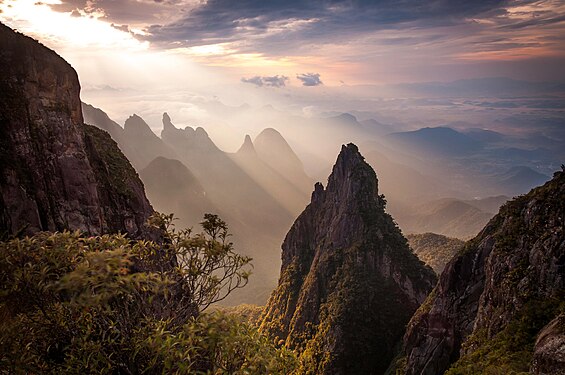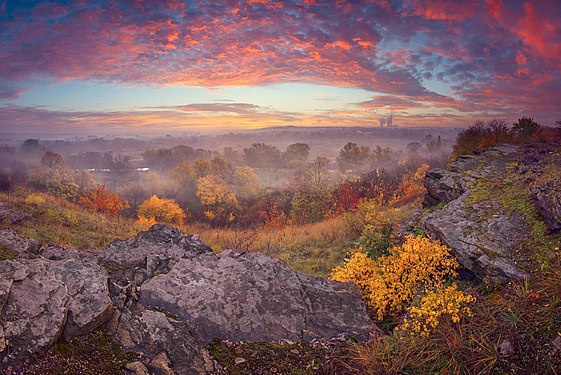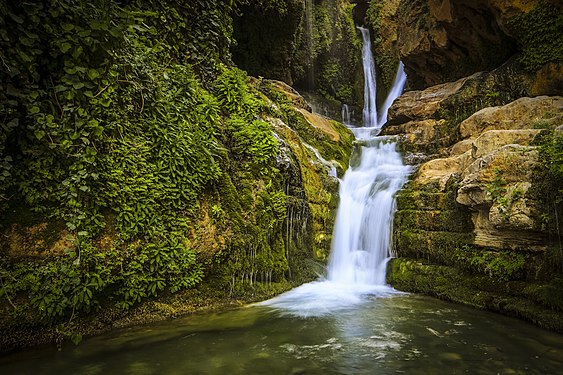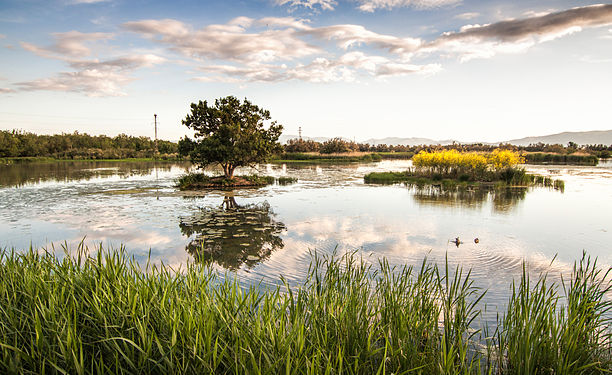Wikimedia Blog/Drafts/Wiki Loves Earth 2015 captures the nature
Title ideas[edit]
- Join Wiki Loves Earth 2015: help capture our natural heritage
Alternates:
- Wiki Loves Earth 2015 focuses on nature
- Join Wiki Loves Earth 2015, with a focus on nature
- Capture the nature in Wiki Loves Earth 2015
- Wiki Loves Earth 2015 captures the nature
- ...
Summary[edit]
Wiki Loves Earth 2015 starts on May 1st, and invites you to contribute photos about the world's natural heritage. This international photo contest is organized by the Wikimedia community, with the help of its Ukrainian and Polish chapters. We hope you will participate!
On 1st May 2015 and volunteers is starting an international photo contest with a natural heritage theme, Wiki Loves Earth 2015.
- ...
Body[edit]

Wiki Loves Earth features exceptional photos of national resources from around the world, such as this image of Aiguamolls de l'Empordà, Spain -- which was selected as one of last year's winners. Photo by Mikipons, freely licensed under CC BY-SA 3.0.
On May 1st, Wiki Loves Earth 2015 will start an international photo contest about our natural heritage. This event is organized by the Wikimedia community, with the help of its Ukrainian and Polish chapters. Many national contests will be hosted as well, coordinated by local volunteers.
Wiki Loves Earth was conceived in 2012, and it was implemented for the first time in Ukraine, where the first contest was held from April 15 to May 15, 2013. It was inspired by the success of Wiki Loves Monuments, with a goal to run a similar contest for natural monuments.
This is the third year for this competition. Watch this video to learn more about the 2014 event, when 16 different countries participated: Algeria, Andorra and Catalan areas, Austria, Azerbaijan, Brazil, Estonia, France, Germany, Macedonia, Nepal, Pakistan, Poland, Portugal, Russia, Spain, Syria,Tunisia, Uruguay, Ukraine -- and many more, who joined forces to share their natural monuments with the world!

View the full report from last year’s international jury, which explains the selection process and includes comments from jury members. A gallery of the 10 winning photos is included at the end of this blog post.
Wiki Loves Earth is still growing and spreading all over the world. We are really happy there is such a big interest in this project. WLE is becoming an active public movement and is now viewed not only as a competition, but also as a prestigious way to tell about your country and the beauty of its natural resources. National committees for Wiki Loves Earth 2015 will launch new channels for users to stay in touch and get regular updates. We invite you to follow these pages and groups, so you can won't miss some of the most interesting, thrilling and significant photos of 2015.
This photo contest is not only a great opportunity to showcase the charms of nature, but also a chance to draw public attention to environmental issues. Together, we can create a worldwide knowledge base of our natural heritage. With your help, Wiki Loves Earth will fill in blind spots on a map and will highlight unknown places and sights. Wiki Loves Earth covers not only sites of national importance, but also areas protected on the regional level and the widest variety of natural sites possible: forests, parks, gardens, rocks, caves and whatever is protected within the participating countries. Together we can raise awareness about these natural resources and help protect them.
Anyone can take part in the competition; however, registration on Wikimedia Commons is required. To participate in the contest, check our competition list, find an item or place you are familiar with, then submit a picture you have taken (past or present), and upload it to Wikimedia Commons between May 1 and May 31, 2015.
Ievgen Voropai, Project coordinator, Wiki Loves Earth 2015
Wiki Loves Earth 2014/Winners

![]() View of Carpathian National Park from Hoverla. Carpathian National Park, Ivano-Frankivsk Oblast.
View of Carpathian National Park from Hoverla. Carpathian National Park, Ivano-Frankivsk Oblast.
Вид з Говерли на Карпатський національний парк. Карпатський національний природний парк, Івано-Франківська область.
Photo by Balkhovitin, freely licensed under CC BY-SA 3.0.
“1 green.svg” by Amakuha, CC0 1.0.
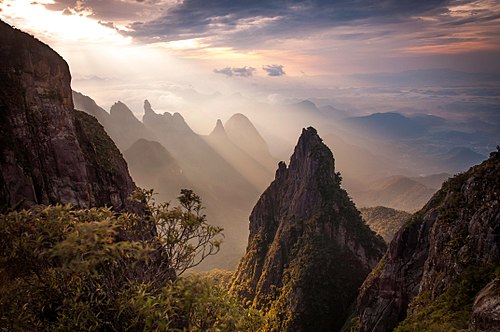
![]() Serra e pico Dedo de Deus no Parque Nacional da Serra dos Órgãos.
Serra e pico Dedo de Deus no Parque Nacional da Serra dos Órgãos.
Горная цепь и пик Деду-де-Деус в Национальном парке Серра-дус-Органус.
Photo by Carlos Perez Couto, freely licensed under CC BY-SA 3.0.
“2 green.svg” by Amakuha, CC0 1.0.

![]() Mukri bog in the october morning mist.
Mukri bog in the october morning mist.
Mukri maastikukaitseala. Hommik rabas.
Photo by Amadvr, freely licensed under CC BY-SA 3.0. ee.
“3 green.svg” by Amakuha, CC0 1.0.

![]() Mount Shaan-Kaya in Clouds. Yalta Natural Reserve, Autonomous Republic of Crimea.
Mount Shaan-Kaya in Clouds. Yalta Natural Reserve, Autonomous Republic of Crimea.
Шаан-Кая у хмарах. Ялтинський гірсько-лісовий природний заповідник, АР Крим.
Photo by Александр Черных, freely licensed under CC BY-SA 3.0.
“4 green.svg” by Amakuha, CC0 1.0.

![]() Peak Krcin, part of the Mavrovo National Park.
Peak Krcin, part of the Mavrovo National Park.
Високо на Крчин, дел од Националниот парк «Маврово».
Photo by MartinDimitrievski, freely licensed under CC BY-SA 3.0.
“5 green.svg” by Amakuha, CC0 1.0.

![]() Sheep in Drents-Friese Wold National Park, Netherlands.
Sheep in Drents-Friese Wold National Park, Netherlands.
Schapen op het Aekingerzand.
Photo by Uberprutser, freely licensed under CC BY-SA 3.0. nl.
“6 green.svg” by Amakuha, CC0 1.0.
![]() Peninsula. Novyi Svit Sanctuary, coastal aquatic system between Novyi Svit and Sudak, Autonomous Republic of Crimea.
Peninsula. Novyi Svit Sanctuary, coastal aquatic system between Novyi Svit and Sudak, Autonomous Republic of Crimea.
Заказник «Новий Світ», Крим.
Photo by Vian, freely licensed under CC BY-SA 3.0.
“7 green.svg” by Amakuha, CC0 1.0.
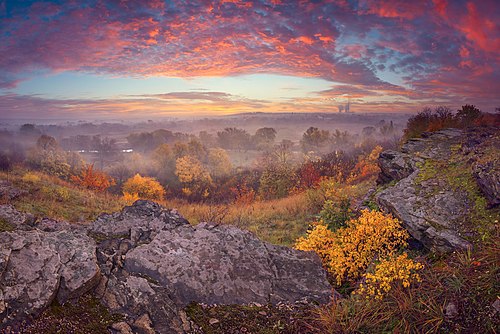
![]() Morning Palette. Zuivskyi Regional Landscape Park, Donetsk Oblast.
Morning Palette. Zuivskyi Regional Landscape Park, Donetsk Oblast.
«Ранкова палітра». Регіональний ландшафтний парк «Зуївський», Донецька область.
Photo by Vian, freely licensed under CC BY-SA 3.0.
“8 green.svg” by Amakuha, CC0 1.0.

![]() Barrage bechloul Haïzer à Bouira.
Barrage bechloul Haïzer à Bouira.
Photo by Chettouh Nabil, freely licensed under CC BY-SA 3.0.
“9 green.svg” by Amakuha, CC0 1.0.

![]() Cascade de Aïn Legradj à Bordj Bou Arreredj.
Cascade de Aïn Legradj à Bordj Bou Arreredj.
Photo by Chettouh Nabil, freely licensed under CC BY-SA 3.0.
“Destination 10.png” by Seloloving, Public Domain
Notes[edit]
Ideas for social media messages promoting the published post:
Twitter (@wikimedia/@wikipedia):
* Join Wiki Loves Earth 2015: help capture our natural heritage and protect our environment. (link) ---------|---------|---------|---------|---------|---------|---------|---------|---------|---------|---------|------/
Facebook/Google+
- Do you like taking photos of nature? If you do, join Wiki Loves Earth 2015. Let the world discover natural sites near you, through your eyes. (link)
- Wiki Loves Earth 2015 starts on May 1st, and invites you to contribute photos about our natural heritage. This international photo contest is organized by the Wikimedia community, and anyone can participate. We hope you will join us! (link)
Gallery[edit]
We can't use this gallery on the Wikimedia blog, because Wordpress doesn't support it, but kept it here, for the record.
Wiki Loves Earth 2014/Winners
-
 View of Carpathian National Park from Hoverla. Carpathian National Park, Ivano-Frankivsk Oblast
View of Carpathian National Park from Hoverla. Carpathian National Park, Ivano-Frankivsk Oblast
Вид з Говерли на Карпатський національний парк. Карпатський національний природний парк, Івано-Франківська область
© Balkhovitin -
 Serra e pico Dedo de Deus no Parque Nacional da Serra dos Órgãos
Serra e pico Dedo de Deus no Parque Nacional da Serra dos Órgãos
Горная цепь и пик Деду-де-Деус в Национальном парке Серра-дус-Органус
© Carlos Perez Couto -
-
 Mount Shaan-Kaya in Clouds. Yalta Natural Reserve, Autonomous Republic of Crimea
Mount Shaan-Kaya in Clouds. Yalta Natural Reserve, Autonomous Republic of Crimea
Шаан-Кая у хмарах. Ялтинський гірсько-лісовий природний заповідник, АР Крим
© Александр Черных -
 Peak Krcin, part of the Mavrovo National Park
Peak Krcin, part of the Mavrovo National Park
Високо на Крчин, дел од Националниот парк «Маврово»
© MartinDimitrievski -
-
 Morning Palette. Zuivskyi Regional Landscape Park, Donetsk Oblast
Morning Palette. Zuivskyi Regional Landscape Park, Donetsk Oblast
«Ранкова палітра». Регіональний ландшафтний парк «Зуївський», Донецька область
© Vian -
-
-
 Kukul in Winter. Carpathian National Park, Ivano-Frankivsk Oblast & Carpathian Biosphere Reserve, Zakarpattia Oblast
Kukul in Winter. Carpathian National Park, Ivano-Frankivsk Oblast & Carpathian Biosphere Reserve, Zakarpattia Oblast
Зимовий Кукуль. Карпатський національний природний парк, Івано-Франківська область; Карпатський біосферний заповідник, Закарпатська область
© User:Хіраш Володимир -
 This beech (Fagus sylvatica) is located on the socalled „Zaglbaueralm“ (alpine pasture of farmer Zaglbauer) approximately 920 m above sea level in the Austrian Limestone Alps National Park . In 2014 the tree is already heavily attacked by fungi.
This beech (Fagus sylvatica) is located on the socalled „Zaglbaueralm“ (alpine pasture of farmer Zaglbauer) approximately 920 m above sea level in the Austrian Limestone Alps National Park . In 2014 the tree is already heavily attacked by fungi.
Die Buche (Fagus sylvatica) auf der Zaglbauernalm steht auf einer Höhe von ca. 920 m im Nationalpark Kalkalpen. Der Baum ist (2014) stark von Baumschwämmen befallen.
© Isiwal -
-
 Brandganzen Ezumakeeg. © Baykedevries
Brandganzen Ezumakeeg. © Baykedevries -
 Ici c'est une vue nocturne de plusieurs villages de Tizi-ouzou envelopper par les nuages - haletat, aussi appelé la Main du Juif, qui culmine à 1 638 m d'altitude, est l'un des sommets du Djurdjura en Kabylie.
Ici c'est une vue nocturne de plusieurs villages de Tizi-ouzou envelopper par les nuages - haletat, aussi appelé la Main du Juif, qui culmine à 1 638 m d'altitude, est l'un des sommets du Djurdjura en Kabylie.
© Chettouh Nabil
... -->


